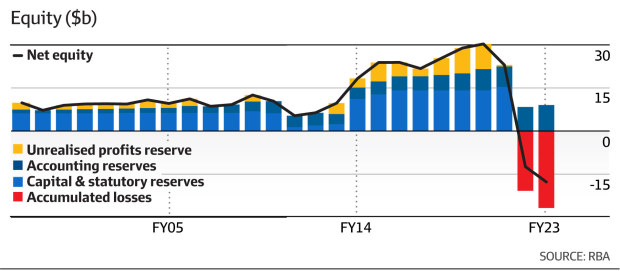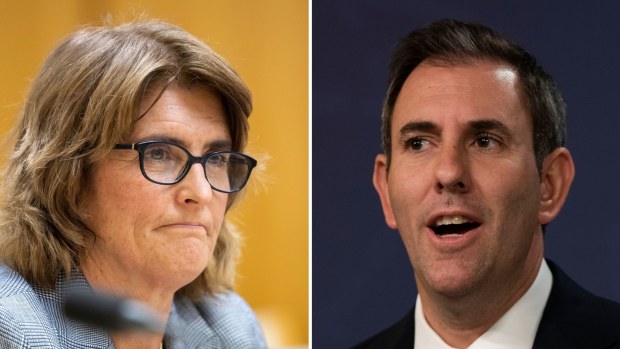RBA’s $43b in losses put pressure on Chalmers for bailout

The Reserve Bank of Australia’s huge financial losses from its extraordinary pandemic stimulus measures have blown out to about $43 billion and sunk its balance sheet deeper into negative equity.
The steep losses have led to calls from economists for Treasurer Jim Chalmers to inject up to $30 billion of emergency capital into the bank, while others have urged the big four banks to be forced to repay some of their windfall gains earned from the RBA’s losses.
Rising interest rates that the RBA pays commercial banks and a plunge in the value of the RBA’s government bond portfolio caused the central bank on Thursday to reveal in its annual report an accounting loss of $6 billion for last financial year, compounding a $36.7 billion loss in 2021-22.
The bank’s balance sheet slumped deeper into the red to a negative equity position of $17.7 billion in 2022-23, meaning that the value of its liabilities exceeded the value of its assets.

A commercial bank or business in negative equity would be bankrupt. But a government-backed central bank that can print money cannot be insolvent.
The RBA projects that its negative equity position will widen to up to $27 billion by 2025 and that it won’t return to positive capital until the 2030s, under four future interest rate scenarios.
“This does not affect the bank’s operations or its ability to perform its policy functions,” former governor Philip Lowe said in the 2022-23 annual report signed on September 6.
“Nonetheless, the board will seek to restore the bank’s capital over time through the retention of future profits, rather than paying these as dividends to the government.
“The Treasurer [Jim Chalmers] has indicated his continued support for this approach, noting that a decision about retention of earnings is made each year.”
Dr Lowe received total remuneration of $1.15 million for the 12 months.
Former RBA board member Warwick McKibbin and former Treasury official Peter Downes called for the government to swiftly inject tens of billions of dollars into the central bank to shore up its balance sheet.
Mr Downes said Dr Chalmers and new governor Michele Bullock should “bite the bullet” and negotiate a recapitalisation, several times bigger than former treasurer Joe Hockey’s $8.8 billion capital injection in 2014.

RBA governor Michele Bullock and Treasurer Jim Chalmers. Alex Ellinghausen/Louise Kennerley
“The central bank is the lender of last resort to banks and people need to have confidence it can step in when a crisis occurs,” Mr Downes said.
“Say the Middle East blows up, and oil prices go to $180 and there is a run on a bank.
“To step in, the RBA would need to ask the treasurer for money during a crisis.
“It would be better to recapitalise the bank sooner rather than being in negative equity for so long.”
Professor McKibbin said the government quickly restoring the central bank to positive capital would be a “much better look”.
Extreme events
“Negative equity complicates extreme events.
“It doesn’t affect monetary policy because in the end the government is standing behind the bank.
“Right now we’re running surprisingly large budget surpluses so why not inject it into the bank?”
A multibillion-dollar capital injection would jeopardise Dr Chalmers recording a second straight budget surplus.
The RBA and government have insisted a recapitalisation is not necessary and the bank can operate monetary policy effectively. The government will not receive the customary circa $2 billion annual dividend for at least a decade as the RBA rebuilds its buffers.
A spokesman for Dr Chalmers said: “The RBA board has an approach to restore the capital position over time, and has made clear this does not affect its operations or ability to perform policy functions. The government supports the RBA’s general approach to restoring its capital over time.”
Sharp interest rate rises have smashed the mark-to-market paper value of $330 billion of federal and state government bonds the RBA bought in the pandemic to reduce government borrowing costs and put downward pressure on the exchange rate.
The RBA will also lose a total of about $8 billion in cash connected to the pandemic-era $188 billion term funding facility (TFF), which gave commercial banks three-year fixed rate loans at ultra-low rates of as little as 0.1 per cent.
The central bank is now paying those same banks a higher floating rate of 4 per cent on $362 billion of excess reserves deposited with the RBA and losing money on the difference between the lending rate and deposit rate.
QE’s hidden cost
Monash University economist and former RBA official Zac Gross said the losses were the “hidden cost” of quantitative easing, but the RBA could force commercial banks to repay some of the benefits they received.
“Quantitative easing involves buying bonds when yields are low and holding them until they are higher, effectively buying when prices are high and selling low – not traditionally the best way to make a profit.
“The RBA could rein in these losses by reducing the interest rate they pay on excess reserves – effectively a tax on the big four banks and Macquarie.”
Commercial bankers have dismissed claims of a subsidy. They argue the cheap RBA funding were passed on to home borrowers via ultra-low fixed rate loans of about 2 per cent. Moreover, banks hedged the interest rate risk in financial markets by swapping the fixed rates into floating rates – reducing any financial windfall.
RBA officials have said lowering the rate paid to banks on excess reserves would interfere in the monetary policy transmission.
As deputy governor last year, Ms Bullock said bond buying and the TFF contributed to a stronger economy, lower unemployment and a better government budget.
“Just considering the financial losses in isolation, I don’t think it’s particularly helpful,” Ms Bullock said.
“I think you have to think about it across government and across the economy.”
Internal RBA modelling concluded the bond program reduced long-term yields by 0.30 of a percentage point, while lowering the currency by 1 to 1.4 percentage points, resulting in “stronger economic activity and inflation than otherwise”.
The independent review of the RBA said that the “lesson from this episode is that additional monetary policies that entail asset purchases amplify the interactions between monetary and fiscal policy, and that additional monetary policies can accrue significant fiscal costs”.
“These programs incur a substantial cost because the interest rate paid by the RBA on reserves used to fund bond purchases and the term funding facility are linked to the cash rate (and so have increased significantly recently), while the returns on the corresponding assets are fixed.
“At the same time, the market value of bonds purchased by the RBA have declined as bond yields have risen, resulting in large unrealised valuation losses.”
But the review noted the costs do not capture benefits such as lower cost of government debt and “modest” boosts to economic activity that helped generate tax revenue and lower expenditure on welfare.
Commercial banks have repaid about $80 billion of the TFF loans and will need to repay a further $108 billion to the RBA by June next year.
About $26 billion worth of bonds have matured and rolled off the RBA’s balance sheet.
The RBA board has been considering actively selling more bonds in the financial market or back to the government to wind down its balance sheet faster than a gradual roll-off of maturing bonds.
Interest rate risk
Assistant governor Chris Kent said last week the RBA didn’t have any current plans to sell bonds.
The board was aware of the “interest rate risk” of holding the large portfolio of bonds, he said, implying that the RBA would suffer further valuation losses if the RBA cash rate rises further. However, selling the bonds would immediately realise a loss.
Many advanced central banks have reported significant losses from
additional monetary policy tools in the pandemic, including the US Federal Reserve, Bank of England and the Bank of Canada. The US Fed’s QE program is estimated to reduce dividends to the US government by $US760 billion over the next decade.
“The Reserve Bank Board decided not to seek a government indemnity for the bond purchase program,” the RBA review noted.
“By contrast, some other central banks use indemnities to transfer gains or losses
from asset purchases directly to the government budget.
“The Reserve Bank board made a judgment that it would ultimately make no difference to the overall public sector balance sheet, as any losses from bond purchases ultimately accrue to the government balance sheet, whether via reduced dividends or an indemnity.
“Nonetheless, the spillovers of additional monetary policy tools to fiscal policy show the importance of ongoing discussions between monetary and fiscal authorities, including consideration in advance of the risks.
“Discussion regarding an indemnity is a clear mechanism to recognise these interactions between monetary and fiscal policy concretely ahead of time.”
The RBA was urged to do QE by former prime minister Paul Keating, now Assistant Treasury Minister Andrew Leigh and academic economists, who accused the RBA of being too slow to act and not being aggressive enough in buying bonds.
But none of them pointed out of the downside risks to the RBA and government.
Mr Downes said: “Quantitative easing by central banks has been a fiscal train wreck around the world.”
Introducing your Newsfeed
Follow the topics, people and companies that matter to you.
Find out moreRead More
Latest In Economy
Fetching latest articles